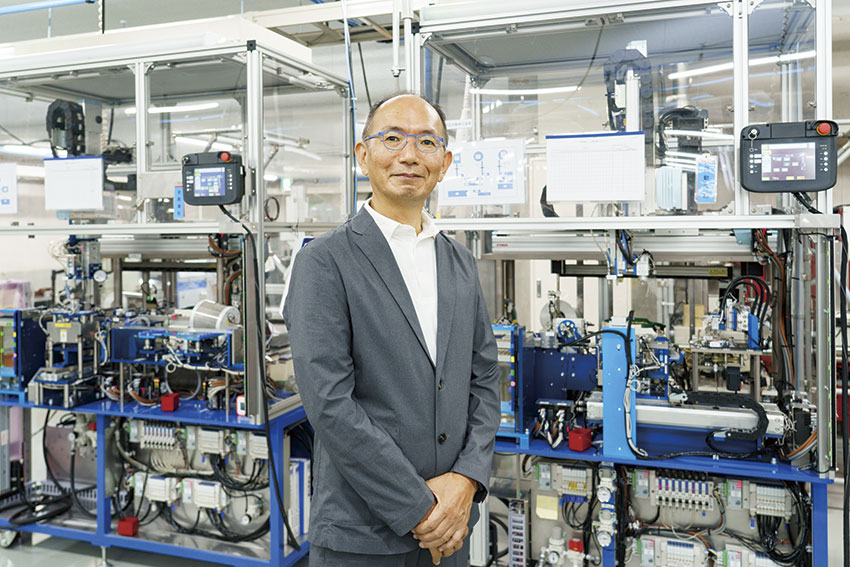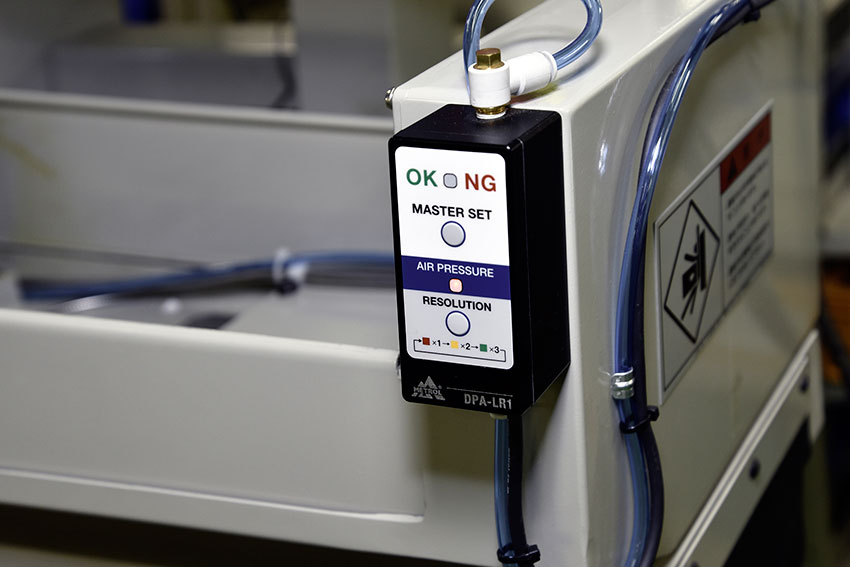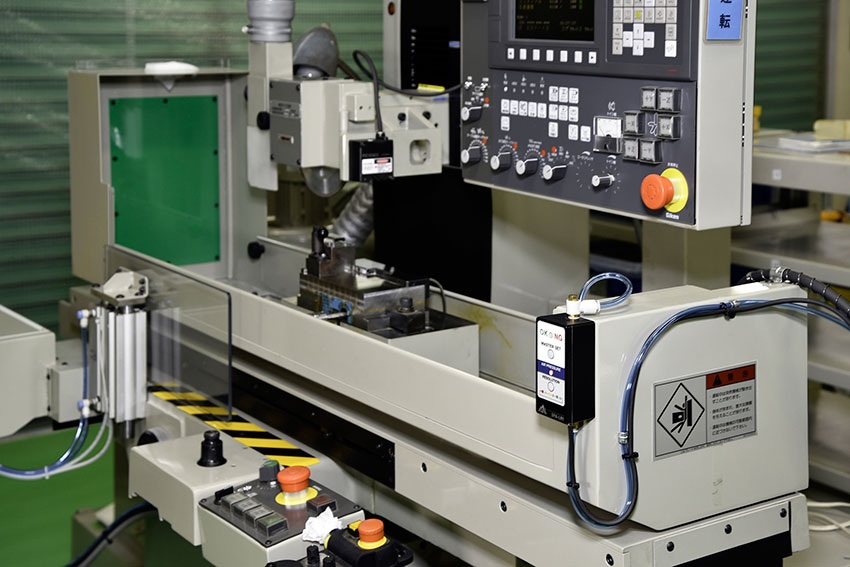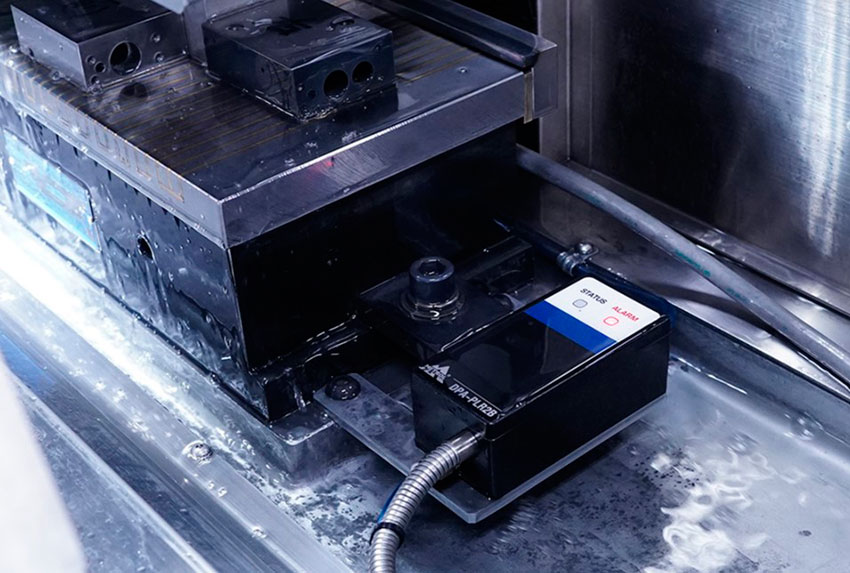Combining ‘measurement’ and ‘control’ under its portmanteau name, Metrol has become a valued B2B company for Japan’s burgeoning manufacturing industry

Can you please share with us your company’s take on monozukuri? What sets you apart from your regional manufacturing competitors and makes you the option of choice for major companies such as Tokyo Electron and FANUC?
Our company’s mission is to relieve humans from simple measurement work. In either the manufacturing of machine tools or semiconductor prediction machinery, you are making a component or part. In every production, there is a stage for inspection, and if there is even a single defect in the product, you must do all the inspection thoroughly once again. Human eyes are always required in the inspection stage, although you can automate the production stage. The inspections are necessary since there can often be defects in the production. Japanese companies have moved out of Japan to lessen the cost of human labor. However, if we create a system where the machine automatically stops when it detects or senses that it may produce defective products, then the inspection stage will no longer be required.
By incorporating our sensors into production machinery, we can detect possible defects or stop the machinery and let it correct itself. This prevents the production of defective components. Our sensors relieve humans from having to carry out the manual inspections of the products, and allows them to focus more on value-added areas which require human capabilities. The reason I feel why Japanese young people do not like to enter into the manufacturing field is because of the simple labor that is required. However, allowing them to have more freedom to fully leverage their capabilities would attract more young people to the industry.
This preventative maintenance technology has become increasingly popular in recent years as a key pillar of this Industry 4.0 style of factory automation. As such we are seeing something of an arms race for companies to develop their own sensing technologies for their own fields. Do you see this trend of people developing their own sensing technologies as more of an opportunity to find new customers or a threat from new players in the market?
Everything is an opportunity for us. *omitted*, the company that you mentioned, actually use our sensors. The sensor that detects the size of the diaphragm of the valve is produced by us. We provide our products under the Metrol name. Our products play a key role at the heart of the automation of machinery and sensing devices. Our purpose is to provide this key component within the total solution that the assembler creates.
What has been the impact of Japan’s aging society for your company?
It is true that we are feeling the impact of the demographic shift, and it is more difficult to hire people from the young generation, especially in the manufacturing field. However, having said that, we have been shifting ourselves towards more automation. The percentage of human labor required within our company’s operations has decreased considerably. In terms of our office, we have introduced cloud systems and on the production site, we have introduced robotics and automated machinery. Therefore, in that sense, we are not struggling.
Conventionally, Japanese craftsmen or engineers have passed on their specialized skills through experience. However, we have now taken all this experience and produced a custom-made machine which can be operated by anyone. Engineers working at the major companies are the ones who are developing these special types of machinery, and we have hired some of these ex-engineers from the major companies. We have also hired young employees who are working together with these experienced engineers, and this has created a synergetic effect.
Many of the major companies that used to do B2C products are no longer in the market due to the harsh competition. The engineers that worked in this B2C field have been entering into the B2B field as a result. Some of these experienced engineers have entered into our company to leverage their skills in the production of specialized skills machinery. These engineers work on our products, and we then sell those products to Foxconn.
You leverage on an e-commerce platform for direct sales. Can you tell us a little more about what motivated you to do so, and the progress of that platform?
Our direct sales site actually started in the year 2000. The reason why we started it was because for example, if we sold our products overseas for JPY 10,000, they went through several brokers, which resulted in the price actually being twenty times higher. When we went to exhibitions, our customers came directly to us with the money asking us to sell the product directly to them, as the products were so expensive. In order to maintain a fair price for our customers, we decided to sell directly to them without using any agents.
My father foresaw the importance of branding products in the B2B market. He named our company and brand as Metrol which is short for “measurement” and “control.” He labelled all our products with the name Metrol so if there are issues with one of our products, the users can search our name on the internet and visit our website. That has had a very positive effect on our sales.
At that time, Japanese business was conducted through bank accounts, and payments were made using bank transfers. However, I thought about using credit cards for overseas customers, and doing B2B sales like B2C sales. Overseas customers were not hesitant to use credit cards for purchasing sample products or replacement products. That was a driving force for our growth in e-commerce sales.
What was the impact of Covid on your direct sales channels? When we spoke to a major machine tools manufacturer for this report, the president told us that they were still struggling to keep up with the renewed demand.
We actually were not impacted by Covid, since we produce and procure materials and components within Japan. Also, we produce our products using our in-house production facilities with our own machining tools. This allowed us to continuously provide sensors to our customers during the Covid period. That was very well received by our customers. We were not impacted by the disruptions in supply chains overseas. The only drawback we had was that it was difficult to get adhesives from Ukraine. Other than that, we did not have any major issues.
Our business model has been the same. We have always developed and produced our products within Japan, and we have been trying to expand our sales overseas through direct sales channels.
When we talk about factory automation (FA), Japan has proved itself a global leader in FA solutions. In contrast, one area in which Japan has lagged behind is in implementing digital technologies and digital solutions. In IMD’s latest digital competitiveness rankings, Japan ranked 28th in the world. What do you think accounts for this disparity? Why do you think Japan has lagged behind when it comes to introducing digital technologies and solutions into the factory?
I think it is a matter of the politics involved. There has not been a standard for digital transformation established yet. Politics are playing a role in establishing this standard. There are strict regulations and the political sphere has been acting negatively on behalf of Japanese companies’ development of technologies. For example, Sony had the technology to create what Apple created. However, due to copyright issues and other political issues, they were hindered from entering into new markets. Even, within the semiconductor industry, Japanese companies had the technology, but were restricted by Japanese regulations.
The complications that have come from this has forced Japan for better or for worse into niche markets. However, Japanese companies have still found success and have managed to dominate these niche fields. Your company is a great example of this phenomenon, as your products are used all around the world, especially for tough operational environments. What is the current focus of your R&D strategy? Is there a new type of product or service that you are developing that you are excited about and would like to share with our readers?
When it comes to our research and development strategy, we have hired very experienced engineers with analog backgrounds, from when Japan was strong in the B2C market. By having these engineers in-house, we can combine their efforts with our younger generation of engineers that come from digital backgrounds. We are trying to amalgamate analog and digital perspectives to develop new types of products.
We are very unique as we have many experienced engineers. At major Japanese companies, the retirement age is often 60 years old. Also, if a project does not go well, engineers may be laid off at an even earlier age by these major companies. We hire these experienced engineers, and create a team with our young engineers. They can use their experience and expertise to help create new products. For example, one of our products that is very unique and can only be produced by us is our Air Gap Sensor. Two of our engineers worked together to create this very unique product. One engineer was 80 years old, and the other was 25 years old. I called this team “The Old Man and the Sea.”

Air Gap Sensor
This is a great example of inter-company collaboration, with the old analog generation and the young digital generation coming together to create a one-of-a-kind product. I would like to know more about the role that collaboration or cocreation plays within your company externally as well. Do you any experience in collaborating directly with your clients or with any overseas sensor companies to create new products?
Yes, we have been collaborating with many Japanese machine tools manufacturers. For example, we have collaborated with Okamoto, who develop a flat type grinder that is automated, and one of a kind. We have also collaborated with Citizen, who make lathes.

Air Gap Sensor
We collaborated together. This product is fully automated, and the two sensors are made by us. This product was launched last month.
We often hear that a great way to gain a foothold in overseas markets is through collaborative efforts to take advantage of not only their technology but their network and resources as well. Do you have any interest in collaborating with overseas machine tool makers in the same way?
We have been collaborating with many overseas machine tools manufacturers. They send us the 3D CAD, and in many cases, they only have a small limited space for the sensor. We try to customize our product so it fits in the limited space they have. We do not only collaborate with machine tool manufacturers. We have also collaborated with a US/European dental tool manufacturer whose tools are used for grinding teeth when there is a cavity. They sent us a request to produce a sensor that was appropriate for their device, and we have been providing our sensors to them.
We provide our products at a very fast speed. When we receive a request, within one week we make a prototype and send it to the client, who then evaluates the product. We communicate back and forth, and decide the price, and if everything is suitable, we then begin production.
We have a production facility where we can cater to the needs of all of our customers. We can provide different types of sensors for every machinery company and every kind of machine. We refer to it as a cell type production system. We have about 10,000 parts that we can assemble to make over 1,000 different types of sensors. If only one unit is required then we can produce it. We do not have any stock, as we produce our orders after receiving them. We then send them to the customers.
We would like to know a little more about your international business development plans. Are there any new sales channels that you are trying to set up, or are there any new markets or industries that you are trying to penetrate?
It is not up to us to decide which new markets to enter, or which region we want to focus on. Rather, it is the customers that come to us. For example, with regards to dentist tools and semiconductor tools, it is those companies that approach us. We analyze if we can provide a custom-made product for them using our technology. At the same time, we do have our sales channels and sales bases. In Southeast Asia and in China, we frequently communicate with machine tools companies.
For example, one of the requests that we received was for a grinding machine that is used to grind the syringe needle. The surface needs to be polished smoothly.. We presented them with our Air Gap Sensor and made it applicable for their product. That is how we have been developing our technology.
You said that you are not looking for a particular market or sector and that your customers come to you. From where have you seen the most demand and queries coming from recently? What kind of new applications are you seeing for you Air Gap Sensor?

Air Gap Sensor
Our Air Gap Sensor detects the gap between the work and the jig, as precision is required for the grinders. For flat type grinding machines, it is used for silicone grinding and polishing. Therefore, we receive a lot of requests from the semiconductor field. Our Air Gap Sensors are also used for cylindrical type grinders, that are used for drive shaft polishing and grinding, so automotive manufacturers and suppliers also contact us.
We spoke earlier about fully automating the production process. We are still at the early stages, however, the mindset in Japan is actually changing. Before, for example, with regard to Citizen’s machines for mass production, they thought that doing measurements within the machine would consume too much time. For them, it was more efficient to do manual inspections. However, if there is one defect, you must inspect all the products, which is becoming more burdensome. In order to make it more efficient, doing the inspections within the machines by lots has become important. That is why they developed new types of machinery using our sensors.
With advancements in software, the engineers can now control the inspection aspect through the dialog on the interface. Right now, there is one machine for each engineer, but once communication is consolidated, the next phase will be to connect the machines with other machines and fully automate the process using IoT systems. That is the future, but before that can be realized in Japan, there are things that need to be done.
In Japan, with the aging population, there is less people who can carry out the simple inspection work, while in Southeast Asia and China, the labor cost is increasing. As a result, companies want to shift to automation, particularly for inspections, in order to reduce the human labor costs. Japan is the pioneer of aging societies, so we are at the forefront of automation.
You mentioned that you have been the president already for more than ten years. Imagine that we come back on the very last day of your presidency when you are about to pass the presidency on to the next generation, and we interview you all over again. What dreams and goals would you like to have achieved for the company by then that you would like to tell us in that new interview?
My goal is not to enlarge the company or make it a listed company so it is more attractive to our stakeholders. Rather, I am more focused on the internal structure of the company, I do not want a hierarchy within the company. I want to focus on team building and overcoming the generational gap through nonviolent communication (NVC), in which we are currently training our employees. By building a strong team and creating an open environment, we hope to continue to create new products and provide our services to the industry. That is my goal for the future.
0 COMMENTS